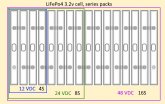maharzan
New Member
- Joined
- Feb 1, 2020
- Messages
- 95
Hi,
I am new and I need some help. This is not a solar project but will also at some point will need help for my solar too. I have a lead acid small EV and need to upgrade to lithium. After looking at the videos and doing some research I have found that using 3.2v 100Ah sinopoly is the best bet, costs cheaper too. So I will need 16 of them in series to make 48v and 2 of these blocks in parallel to make 200Ah. But I recently saw you have to connect first in parallel and then in series so does that mean I add 2 batteries in parallel and 16 of these blocks in series? why is that? Also I saw that you only need 1 bms in this case. I need some recommendation on which BMS to buy so the max current it can draw while using the ev is 350A. Can the bms also monitor all 32 cells or just 16 in this case?
Thank you all for your help.
Chandra
I am new and I need some help. This is not a solar project but will also at some point will need help for my solar too. I have a lead acid small EV and need to upgrade to lithium. After looking at the videos and doing some research I have found that using 3.2v 100Ah sinopoly is the best bet, costs cheaper too. So I will need 16 of them in series to make 48v and 2 of these blocks in parallel to make 200Ah. But I recently saw you have to connect first in parallel and then in series so does that mean I add 2 batteries in parallel and 16 of these blocks in series? why is that? Also I saw that you only need 1 bms in this case. I need some recommendation on which BMS to buy so the max current it can draw while using the ev is 350A. Can the bms also monitor all 32 cells or just 16 in this case?
Thank you all for your help.
Chandra




